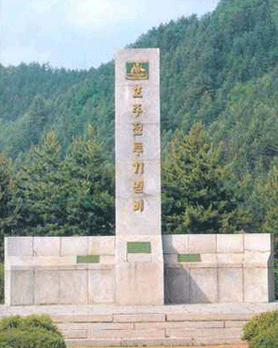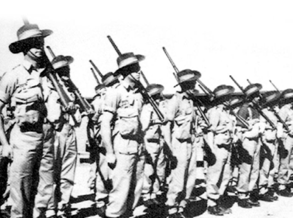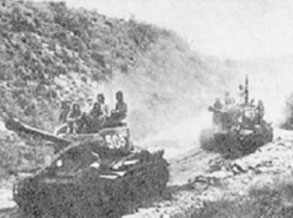box
.box.image

This program was initiated in 2003 to enable next of kin family members to visit the graves or the memorials of their fallen loved ones.
The goal of the Revisit Korea Program is to express gratitude to the Korean War veterans from the 22 UN Sending States and to foster pride by letting them witness how Korea enjoys peace and prosperity today thanks to their noble sacrifices and dedication in the past.
.box.image.type2

Monument for the Participation of Australia in the Korean War
Australia dispatched Army, Air Force, and Navy units as a part of the UN forces for World peace when the korean War broke out.
In order to commemorate their participation, and to respect their heroic death in the korean war, the Association of UN Participated Nations in korea established the monument on April 24, 1963. It was reestablished December 27, 1983.
.box.image.type3

on board at the port of Hungnam
Battle of Kimhwa Jatgol (1953. 2. 26~4. 21)
The 3rd US Division advanced northward from Wonsan as the UN and South Korean forces near the Chosin Reservoir were in a predicament.
This brought about security problems in Wonsan and they lost Wonsan and the adjacent area south of the city to the enemy.
Thus, the 10th US Army Corps and the 1st Korean Army Corps had to withdraw to the sea as their retreat path was blocked.
The first unit that withdrew from Hungnam was the 3rd Korean Division, and then, the 1st US Marine Division evacuated from the area.
While the evacuation continued, the communist forces took on the fierce offensive.
The UN and South Korean forces fought against the enemy taking into account that it would be difficult to secure a bridgehead unless they
.box.image.type3.none
Battle of Kimhwa Jatgol (1953. 2. 26~4. 21)
The 3rd US Division advanced northward from Wonsan as the UN and South Korean forces near the Chosin Reservoir were in a predicament.
This brought about security problems in Wonsan and they lost Wonsan and the adjacent area south of the city to the enemy.
Thus, the 10th US Army Corps and the 1st Korean Army Corps had to withdraw to the sea as their retreat path was blocked.
The first unit that withdrew from Hungnam was the 3rd Korean Division, and then, the 1st US Marine Division evacuated from the area.
While the evacuation continued, the communist forces took on the fierce offensive.
The UN and South Korean forces fought against the enemy taking into account that it would be difficult to secure a bridgehead unless they
.box.photo
.box.photo.type2
.box.icon
Privacy
When you visit this web site, we make a record of your visit and log the following information for statistical purposes : the user's server address; the date and time of visit to the site, etc
RSS
This homepage provides the information relating by RSS. With the RSS service, users may receive the updated latest materials without having access to the homepage. Please register into the RSS Reader the menus that you want from the following menu lists.
.box.basic
box_inner
box_inner
box_inner
img_zoom
Number of veterans invited
Purpose
The goal of the Revisit Korea Program is to express gratitude to the Korean War veterans from the 22 UN Sending States and to foster pride by letting them witness how Korea enjoys peace and prosperity today thanks to their noble sacrifices and dedication in the past.
list
.bu
- Implications of the Korean War on world history
- The role of the Armistice Agreement and UN Command
- Ways to improve rehabilitation policies for veterans
.bu.dl
-
February 1976 Hongik University Girls’ High School
-
February 1980 B.A. in Management, Sookmyung Women’s University
-
February 1982 M.A. in Management, Sookmyung Women’s University
-
February 1988 Ph.D in Human Resources Economics, Université Paris 1 Panthéon-Sorbonne
.num
- 1Implications of the Korean War on world history
- 2Implications of the Korean War on world history
- 3Implications of the Korean War on world history
caution
cautionImplications of the Korean War on world history
blt
Implications of the Korean War on world history
point
point text 1 point text 2 point text 3btn
box text box text box textbox text box text box text
popup
Welfare Policy Division
- 1Establishment of a basic plan for veterans' medical care and generalization and adjustment of medical policies
- 2Establishment of a basic plan for veterans' medical care and generalization and adjustment of medical policies
- 3Establishment of a basic plan for veterans' medical care and generalization and adjustment of medical policies
table
.table
| Title | Title | Title |
|---|---|---|
| Contents |
|
|
| Contents |
|
.table
| Title | Contents |
|---|---|
| Title | Contents |
.table
| Title | Title | |
|---|---|---|
| Title | Title | |
| Contents | Contents | Contents |
| Contents | Contents | Contents |
.table.responsive
| Title 1 | Title 2 | Title 3 |
|---|---|---|
| Contents 1-1 | Contents 1-2 | Contents 1-3 |
| Contents 2-1 | Contents 2-2 | Contents 2-3 |
.table_scroll
| Title 1 | Title 2 | Title 3 |
|---|---|---|
| Contents 1-1 | Contents 1-2 | Contents 1-3 |
| Contents 2-1 | Contents 2-2 | Contents 2-3 |
pattern_box
At the dawn of June 25, 1950, North Korean forces began the sudden invasion of South Korea.
North Korean forces premeditated the invasion and started the attack targeting Seoul.
North Korea tried to conceal the fact that they launched a provocative and premeditated invasion to South Korea and hold the South accountable for the war by claiming that they launched a counterattack as South Korea invaded the North.
However, numerous evidence shows that the North's claim is all false.
In particular, relevant data released by communist nations, especially Russia, after the war clearly shows that the Soviet Union, China and North Korea premeditated the war and began the invasion to South Korea. Moreover, a large number of communist officials who participated in the war testified that North Korea invaded South Korea.
Also, the former President of Russia Boris N. Yeltsin provided the former President of Korea Kim Young-sam, who was on his state visit to Russia in 1994, with classified documentation related to the Korean War that says the war began as Joseph V. Stalin approved Kim Il-sung's request.
Therefore, those who insisted that South Korea invaded the North lost the grounds to their claim. On June 26, 1950, Uijeongbu, a city located just north of Seoul, was captured by the North Korean forces. The South Korean forces made utmost efforts to establish a defensive post. At night of June 27, 1950, the North Korean forces resumed the attack and at the dawn of June 28, 1950, Seoul fell into the hands of North Korean forces.
flag_box

The war monument for the Australia 3rd Battalion
located in Gapyung-gun Jukdun-ri
